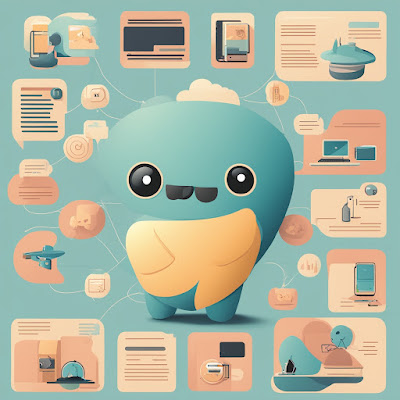In the vast expanse of programming languages, a diverse array of tools empowers developers to craft solutions across myriad domains. From the stalwart Java to the expressive Python, the performant C++ to the dynamic JavaScript, each language brings its own strengths and specialties to the table. In this cosmic journey through the galaxy of programming languages, we'll explore their applications, future prospects, and provide illustrative instances.
1. Java: The Titan of Enterprise Development
Java, a titan in the realm of enterprise development, boasts platform independence, robustness, and scalability. Its object-oriented paradigm and extensive libraries make it ideal for building large-scale applications, especially in banking, e-commerce, and enterprise resource planning (ERP) systems.
Future Scope: With its stronghold in Android app development and adaptability to emerging technologies like cloud computing and Internet of Things (IoT), Java's future remains bright.
Example: Developing a robust banking application that processes millions of transactions daily showcases Java's prowess in handling complex, mission-critical systems.
2. Python: The Swiss Army Knife of Programming
Python's simplicity, readability, and versatility have catapulted it to the forefront of programming languages. From web development to data science, machine learning to automation, Python serves as a Swiss Army knife for developers across diverse domains.
Future Scope: Python's dominance in artificial intelligence, data analytics, and scientific computing ensures its relevance in an increasingly data-driven world.
Example: Building a data analytics platform using Python's rich ecosystem of libraries demonstrates its efficacy in extracting actionable insights from vast datasets.
3. C++: The Workhorse of Performance
C++, renowned for its performance and efficiency, finds its niche in performance-critical applications such as game development, system programming, and embedded systems. Its balance between high-level abstraction and low-level control over hardware makes it indispensable in resource-constrained environments.
Future Scope: With the rise of technologies like autonomous vehicles and real-time simulations, C++ continues to be the language of choice for developing high-performance, mission-critical systems.
Example: Creating a real-time rendering engine for a high-end gaming console exemplifies C++'s ability to optimize memory usage and deliver stunning visuals.
4. JavaScript: The Backbone of the Web
JavaScript, the backbone of the web, enables dynamic and interactive user experiences in both frontend and backend development. Its asynchronous nature, coupled with frameworks like Node.js and React, facilitates responsive web applications and single-page applications (SPAs).
Future Scope: JavaScript's expanding role in server-side development, progressive web apps, and desktop applications ensures its prominence in the ever-evolving landscape of web development.
Example: Developing a social media platform with real-time updates showcases JavaScript's prowess in creating engaging user interfaces.
5. Ruby: The Elegant Language for Web Development
Ruby, celebrated for its elegant syntax and developer-friendly features, shines in web development, particularly with the Ruby on Rails framework. Its emphasis on convention over configuration and Don't Repeat Yourself (DRY) principle enhances developer productivity and code maintainability.
Future Scope: Despite facing competition from newer languages and frameworks, Ruby's focus on developer happiness and rapid prototyping ensures its relevance in agile web development.
Example: Building a content management system (CMS) using Ruby on Rails exemplifies its simplicity and efficiency in creating web applications.
6. Swift: The Future of iOS Development
Swift, Apple's modern programming language for iOS, macOS, watchOS, and tvOS development, combines performance with safety and ease of use. Its concise syntax and powerful features make it the preferred choice for building native iOS apps with enhanced performance and security.
Future Scope: As the Apple ecosystem continues to evolve, Swift's role in iOS app development remains pivotal, with updates and enhancements driving innovation in mobile applications.
Example: Crafting a feature-rich mobile application for iOS devices demonstrates Swift's capabilities in delivering seamless user experiences.
7. Go: The Language for Scalable Systems
Go, created by Google, excels in building scalable and concurrent systems, making it ideal for cloud-based applications, microservices, and distributed systems. Its simplicity, efficiency, and built-in support for concurrency enable developers to write robust and high-performance code with ease.
Future Scope: With the growing demand for cloud-native applications and microservices architecture, Go's future looks promising as a language for building scalable and resilient systems.
Example: Developing a cloud-based web service with concurrent request handling highlights Go's ability to scale gracefully under high loads.
8. Rust: The Language of Safety and Performance
Rust, lauded for its emphasis on memory safety and performance, is gaining traction in systems programming, particularly for building secure and efficient software. Its ownership model and borrow checker ensure memory safety without sacrificing performance, making it suitable for projects where reliability is paramount.
Future Scope: With concerns around security and reliability becoming increasingly critical, Rust's role in developing secure and performant software is set to expand.
Example: Building a high-performance networking application with Rust showcases its ability to combine safety with low-level control.
9. Kotlin: The Modern Language for Android Development
Kotlin, endorsed by Google as a first-class language for Android development, offers interoperability with Java and modern language features that enhance developer productivity. Its concise syntax, null safety, and expressive features make it an attractive alternative to Java for Android app development.
Future Scope: With Google officially adopting Kotlin for Android development, its future as a language for building mobile applications looks promising.
Example: Developing a feature-rich Android app using Kotlin demonstrates its ability to streamline development and improve code readability.
10. TypeScript: The Superset of JavaScript
TypeScript, a superset of JavaScript with optional static typing, brings type safety and tooling support to JavaScript development. Its ability to catch errors early and enhance code maintainability makes it popular for building large-scale JavaScript applications.
Future Scope: As JavaScript applications grow in complexity, TypeScript's role in improving code quality and developer experience is poised to expand.
Example: Creating a robust web application using TypeScript illustrates its benefits in preventing runtime errors and facilitating code refactoring.
The galaxy of programming languages offers a rich tapestry of tools and technologies for developers to explore and leverage in their projects. Whether it's the robustness of Java, the versatility of Python, or the performance of C++, each language contributes to the ever-evolving landscape of software development, shaping the future of technology and innovation.
















